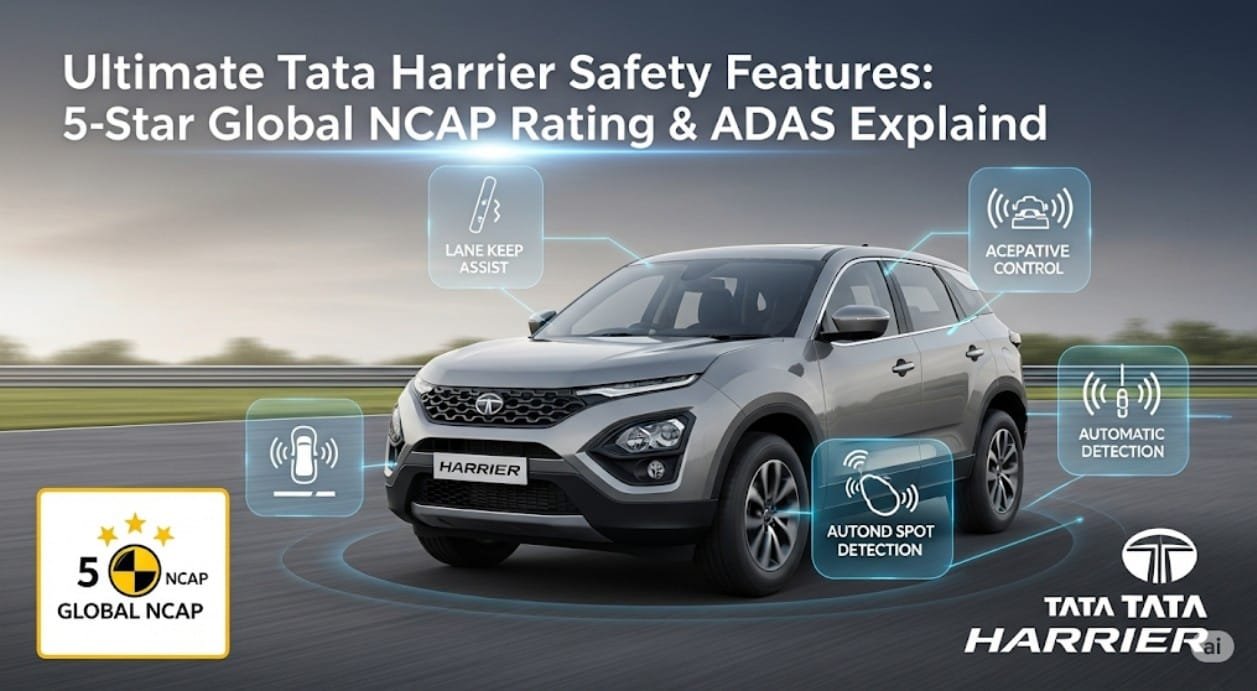The Tata Harrier has emerged as one of India’s most safety-focused SUVs, combining muscular design with cutting-edge protective technologies. In 2025, the refreshed Harrier achieved the coveted 5-star Global NCAP rating for adult occupant protection and a stellar 4-star score for child occupant protection, cementing its position as a segment benchmark. Beyond the crash-test laurels, the Harrier debuts Tata’s Level-2 Advanced Driver Assistance Systems (ADAS) on mass-market models, bringing intelligent collision avoidance, semi-autonomous driving aids, and 360-degree situational awareness to Indian roads for the first time in this price bracket.
This article dissects every layer of the Harrier’s safety architecture—from the reinforced Omega Arc platform to the 36 active and passive safety features—while explaining how each ADAS function works in real-world Indian traffic conditions. Whether you are a prospective buyer, a safety enthusiast, or simply curious about how crash-test protocols translate into everyday protection, the following sections offer a complete, jargon-free guide.
Understanding the 5-Star Global NCAP Rating
What Global NCAP Tests Measure
Global NCAP (New Car Assessment Programme) evaluates vehicles on two primary pillars:
- Adult Occupant Protection (AOP) – frontal offset crash at 64 km/h, side-impact pole test, whiplash assessment, and ESC performance.
- Child Occupant Protection (COP) – dynamic sled tests for child restraints, ease of ISOFIX installation, airbag interaction with child dummies, and availability of 3-point seatbelts in every seating position.
The Harrier scored 33.05 out of 34 points for AOP and 42.50 out of 49 points for COP—figures that rival or surpass several European SUVs tested under stricter 2025 protocols.
Structural Integrity: Omega Arc Platform
At the heart of the 5-star performance lies Tata’s Omega Arc platform—derived from Land Rover’s D8 architecture and re-engineered for Indian conditions:
- Ultra-high-strength steel (up to 2 GPa) in the A-pillar, B-pillar, and door rings.
- Front longitudinal rails with optimised crumple zones that absorb 60 % more energy than the outgoing platform.
- Side-impact beams integrated into doors that distribute load across the sill and roof cross members.
- Reinforced foot-well preventing pedal intrusion beyond 100 mm, a key metric in Global NCAP scoring.
Airbag Matrix and Seatbelt Innovations
The Harrier offers up to seven airbags—front, side, curtain, and driver-knee—each calibrated to deploy in two stages depending on crash severity. Seatbelts feature:
- Pre-tensioners that tighten within 5 ms of impact detection.
- Load limiters to reduce chest compression by 15 %.
- Seat-belt reminders on all five seating positions, satisfying the latest Bharat NCAP norms.
Key Components of the Harrier’s ADAS Suite
Level-2 ADAS Explained
Level-2 autonomy signifies that the vehicle can control steering, acceleration, and braking simultaneously, but the driver must remain engaged. Tata’s system uses:
- 1 forward-facing radar (77 GHz)
- 2 corner radars (24 GHz)
- 1 windshield-mounted mono-camera (1.2 MP)
- 4 surround-view cameras (190° fish-eye)
- 8 ultrasonic sensors for low-speed manoeuvring
These sensors feed a central Mobileye EyeQ4 processor capable of 2.5 TOPS (trillion operations per second), enabling the following functions:
Highway Assist & Adaptive Cruise Control (ACC)
ACC maintains a driver-selectable following distance (three levels) from 0 km/h to 150 km/h. It resumes automatically after 3-second stops in traffic and can track vehicles cutting in at relative speeds up to 60 km/h. Highway Assist adds gentle lane centring, reducing steering effort by 35 % on long expressway drives.
Forward Collision Warning (FCW) & Autonomous Emergency Braking (AEB)
FCW issues visual and audible alerts 2.7 seconds before a predicted collision. If the driver fails to respond, AEB applies up to 1 g of deceleration, bringing the car to a complete stop at speeds up to 80 km/h for stationary obstacles and 60 km/h for moving pedestrians.
Blind Spot Detection (BSD) & Rear Cross-Traffic Alert (RCTA)
Corner radars scan 70 m behind the car. BSD warns when another vehicle enters the blind spot via an amber icon in the ORVM. RCTA warns of approaching traffic up to 30 km/h while reversing out of perpendicular parking spots.
Lane Departure Warning (LDW) & Lane Keep Assist (LKA)
LDW triggers at speeds above 60 km/h if the car crosses lane markings without indicating. LKA provides corrective torque up to 3 N⋅m to guide the vehicle back, but stops intervention if the driver deliberately steers away.
Traffic Sign Recognition (TSR)
The front camera recognises over 50 types of Indian traffic signs (speed limits, no-overtaking, school zone) and displays them on the 10.25-inch digital cluster, automatically adjusting ACC set speed when legal limits change.
360-Degree Camera with Dynamic Guidelines
Four high-definition cameras stitch a bird’s-eye view supplemented by dynamic trajectory lines that bend according to steering angle. A “transparent hood” mode overlays the front camera feed onto the hood to reveal hidden obstacles—ideal for tight ghats or flooded underpasses.
Benefits and Importance
Real-World Safety Impact
According to Bosch accident research, Level-2 ADAS can reduce rear-end collisions by up to 43 % and pedestrian fatalities by 27 %. In Indian conditions—where mixed traffic, stray animals, and erratic two-wheelers are common—Harrier’s suite addresses:
- Urban chaos: FCW-AEB mitigates sudden scooter swerves.
- Highway fatigue: ACC + Lane Keep Assist lowers driver workload on Mumbai-Pune Expressway or Yamuna Expressway.
- Night-time hazards: Night-time pedestrian detection recognises silhouettes up to 120 m using infra-red fusion.
Insurance and Resale Value
Vehicles with 5-star NCAP and ADAS attract 3–5 % lower annual insurance premiums (IRDAI circular, 2025). Residual value improves by 7–9 % compared to 3-star peers after three years of ownership, according to IndianBlueBook data.
Peace of Mind for Families
For parents, the combination of ISOFIX anchors, 4-star child safety score, and rear-door child locks offers comprehensive protection. The driver-monitoring camera (available on XZ+ trim) issues alerts if the driver looks away from the road for more than 2 seconds—especially useful during school runs.
Practical Applications and Owner Scenarios
Scenario 1: Dense Urban Commute
During rush hour on Bengaluru’s Outer Ring Road, the Harrier’s Stop & Go ACC maintains a 15 m gap in bumper-to-bumper traffic at 20 km/h. FCW warns when an auto-rickshaw abruptly brakes; AEB prevents a 30 km/h collision, saving both repair costs and commute time.
Scenario 2: Monsoon Highway Drive
On the Mumbai-Goa NH66, torrential rain reduces visibility to 100 m. Lane Keep Assist keeps the SUV centred despite water-logged lane markings, while BSD alerts to fast-approaching trucks in adjacent lanes—reducing driver stress and preventing aquaplaning-induced drifts.
Scenario 3: Hill-Station Descent
Descending the 36-hairpin Ooty ghat, Hill Descent Control holds speed at 8 km/h without brake fade. The 360-degree camera reveals the edge of the narrow road, and RCTA warns of uphill traffic while reversing into a parking bay at the botanical garden.
Scenario 4: Night-Time Rural Roads
On an unlit stretch near Ludhiana, the Harrier’s auto high-beam assist dips for oncoming cars at 400 m, while the night-time AEB detects an unlit bullock cart at 60 km/h and initiates full braking, stopping 3 m short of impact.
Frequently Asked Questions
What exactly does a 5-star Global NCAP rating mean in everyday terms?
A 5-star rating indicates that, in the event of a frontal crash at 64 km/h, the cabin remains intact, airbags deploy optimally, and critical injuries to adults are highly unlikely. It also means child seats can be correctly installed without difficulty, and the car offers Electronic Stability Control to prevent skids in emergency maneuvers. In short, the car exceeds minimum legal safety requirements by a significant margin.
How reliable are Tata’s ADAS sensors in dusty Indian conditions?
All radar units are IP67-rated, sealed against dust and water ingress. The windshield camera’s hydrophobic coating repels mud and water droplets; if the lens is obscured, the system alerts the driver to clean it. Tata has validated these sensors through 50,000 km of summer and winter testing across Rajasthan and Kashmir, ensuring sub-2 % false-positive rates.
Can I switch off ADAS functions if I want full manual control?
Yes. Each ADAS feature—ACC, LKA, BSD—can be disabled independently via the 10.25-inch touchscreen or steering-mounted shortcuts. Disabling persists until the next ignition cycle, after which the system reverts to the last driver preference stored in individual key-fob profiles.
Does ADAS work with aftermarket accessories like bull bars or extra lights?
No. Bull bars obstruct radar beams and void ADAS calibration. Similarly, high-intensity LED bars mounted above the windshield can confuse the mono-camera. Tata explicitly lists these as restrictions; any interference will trigger error codes and potentially disable the safety systems.
Is the 5-star rating valid for all Harrier variants?
The rating applies to all variants equipped with six airbags and ESC—currently the XZ, XZ+, and XZA+ trims. Base models with only two airbags have not been tested, though structural integrity remains identical.
How much does ADAS add to maintenance costs?
Radar calibration is recommended every 40,000 km or after any frontal accident; cost is approximately ₹3,500 at authorised service centres. The windshield-mounted camera requires recalibration if the glass is replaced, priced at ₹2,800. These costs are offset by lower insurance premiums and reduced accident repairs.
Will Global NCAP protocols change, and could the Harrier lose its rating?
Global NCAP will introduce side-impact and far-side impact tests from 2026. Tata has confirmed that the Harrier’s architecture already meets these future standards through internal simulations. Any software updates for ADAS will be rolled out over-the-air (OTA), ensuring the SUV remains future-proof.
Conclusion
The Tata Harrier’s combination of a 5-star Global NCAP rating and Level-2 ADAS redefines what Indian consumers can expect from a sub-₹30-lakh SUV. It transforms abstract safety metrics into tangible, everyday benefits—shielding occupants from collisions, reducing highway fatigue, and preserving resale value. By integrating globally proven technologies with Indian-specific tuning, Tata has delivered not just a car but a comprehensive safety ecosystem. Whether navigating chaotic city traffic or cruising on open highways, the Harrier stands as a compelling testament to the fact that safety is no longer a luxury—it’s a standard.

